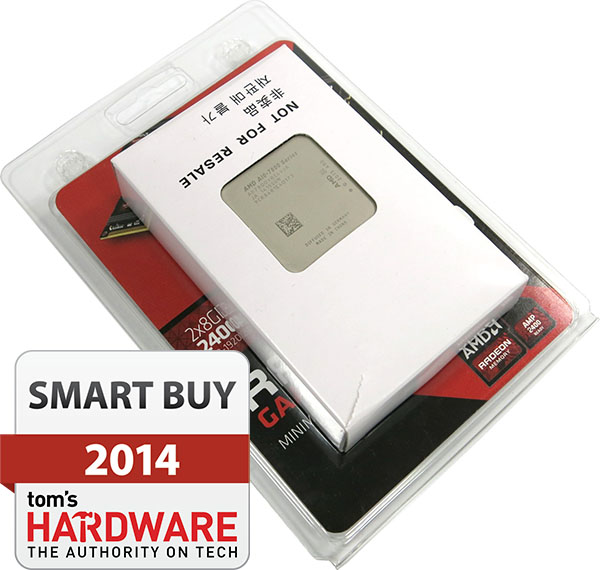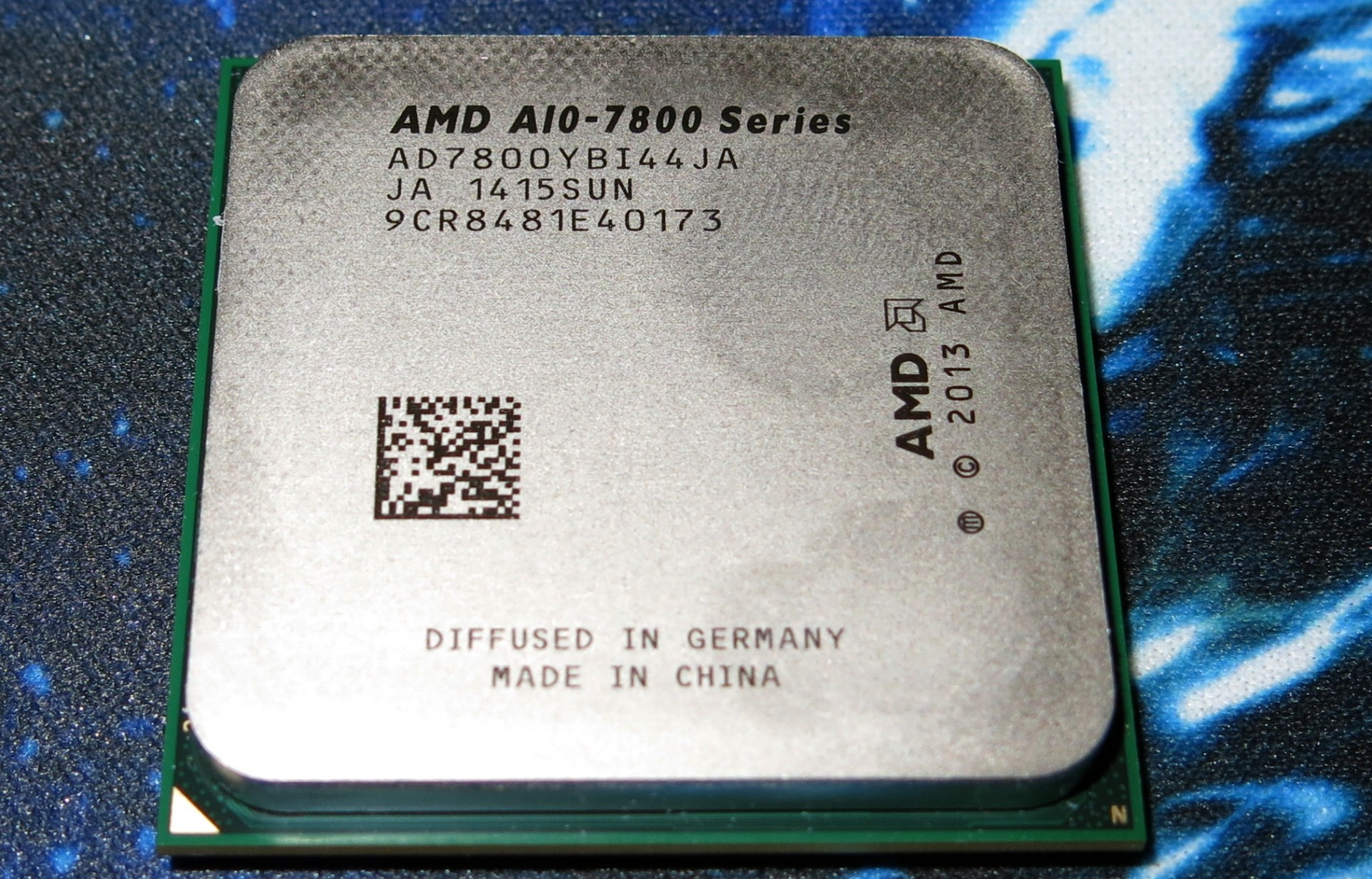AMD A10-7800 APU Review: Kaveri Hits the Efficiency Sweet Spot
AMD recently introduced another model in its A-series APU family called the A10-7800. While we already know a lot about the Kaveri architecture, this particular chip's power profile makes it more interesting than the performance-oriented incarnations.
AMD Turns Over a New Leaf with the Efficient A10-7800
Is this just another APU from AMD? Not quite. The A10-7800 has a different purpose than the flagship -7850K, and that's good news. AMD found the right spot between moderate performance and modest power consumption. As a result, the A10-7800 is a winner if you're building a well-balanced, low-cost PC where price, performance, and efficiency are well-balanced. Yes, you could easily build a faster system using a CPU and discrete graphics card, but it'd almost certainly pull more power from the wall, and would probably be pricier, too.
That combination of attributes, culminating in commendable efficiency, is the A10-7800's unique selling point. You get this from AMD's factory settings. As a result, we don't believe that attaching discrete graphics is a good idea. If gaming is your bag, then find a dedicated host processor and build from there. Otherwise, you're losing the APU’s only advantage, while suffering the compromises of a multi-GPU machine. Besides that, you’d affect the price/performance equation in a negative way. For instance, compare the power draw of a Radeon R7 250 with this APU. The processor gives you a comparably-fast graphics engine with x86 cores thrown in at lower consumption levels. This earns the A10-7800 our Tom's Hardware Smart Buy recognition. If you're considering an APU, the -7800 is the family's purpose-built solution (more so than the -7850K or -7700K).
And of course, if you yearn for high efficiency, the other system components also matter. This APU isn't cheap, and it's too easy to jeopardize those balanced figures we measured with platform parts that aren't complementary. An Athlon X4 760K and Radeon R7 250 would cost about the same. The APU is self-contained, though. And because it takes up less room, your case can be both smaller and easier to cool. The A10-7800 sets itself up to be the engine at the heart of a truly compact entry-level computer.
For such an application, you'd probably want a well-built mini-ITX motherboard. Short of that, MSI's A88XM Gaming proves itself to be an energy efficient microATX alternative, drawing a mere 4-8 W. It's armed with a feature-rich BIOS that lets you optimize the APU's behavior further. Given a shortage of exemplary Socket FM2+-based boards, we're glad we picked this one for our experiment.
If you want to build a home theater or general-purpose PC for casual gaming and office work, the A10-7800 is a smart choice. Just add fast memory (to feed the graphics engine) and a good motherboard. AMD hits the sweet spot, closing the gap between its A10-7700K and -7850K.
In fact, the A10-7800 is an even better option than the -7850K, since that APU's slim performance gain comes at a significant cost to efficiency. You won't notice the -7800's slightly lower performance. What you should be impressed by is the fact that we ran the whole system, including a 480 GB SSD, from a diminutive DC-DC converter and an efficient external AC adapter rated for 65 W. With the addition of a closed-loop liquid cooler, the system draws less than 55 W at the wall. I think it's possible to get below 50 W with an air cooler and some more tweaking. That's an amazing feat and a welcome surprised from a company commonly critiqued for power-hungry processors.
Get Tom's Hardware's best news and in-depth reviews, straight to your inbox.
Current page: AMD Turns Over a New Leaf with the Efficient A10-7800
Prev Page Power Draw: Comparing the Logs
Igor Wallossek wrote a wide variety of hardware articles for Tom's Hardware, with a strong focus on technical analysis and in-depth reviews. His contributions have spanned a broad spectrum of PC components, including GPUs, CPUs, workstations, and PC builds. His insightful articles provide readers with detailed knowledge to make informed decisions in the ever-evolving tech landscape
-
blackmagnum Just to wonder if Microsoft or Sony were to put this chip in their next gaming consoles and give those gamers a fighting chance.Reply -
tiger15 You are stressing power efficiency.Reply
What about comparing those numbers with other offerings? (Intel?) -
Memnarchon Reply13989815 said:Just to wonder if Microsoft or Sony were to put this chip in their next gaming consoles and give those gamers a fighting chance.
Maybe the new consoles lack CPU power (even if they are 8 core, the 1,6Ghz/1,75Ghz cripples them), their GPU part is far more powerful than existing APUs.
PS4's GPU has cores like 7870 and XBOX1 has cores like 7790, in other words more powerful than the 512 core R7 which exists in today's best APU A10-7850K. -
Cryio Wait. You can now CrossFire A10 7850 with GPUs other than the 240 and 250X?Reply
I have a friend with a 7850K and a 260X and he's dying to know if he can CrossFire.
"I see no point in buying a processor that emphasizes on-die graphics and then adding a Radeon R7 265X. Yes, AMD officially recommends it and yes, we tried it out." Can I take this as a yes ? -
gadgety The A8-7600 seems to be the effiency sweet spot in the Kaveri line up, specially at 45W. Trying to compare with of the A10-7800 with the A8-7600, although as far as I can tell just about ALL your tests seem to be done at different settings (e.g. BioShock Infinity is run at Medium Quality Presets rather than the lowest settings as in the test of the A10-7800) so the comparison isn't straightforward. A8-7600 is within 91-94% of the A10-7850K. One item which is comparable is video encoding in Handbrake, where the A8-7600 is at 92.8% of the 7850k, whereas the A10-7800 is at 95.7% of the 7850k. Price wise you'd pay a 63% premium for the A10-7800 over the A8-7600 to get an extremely minute performance advantage, around 3% or so.Reply -
Drejeck Reply
Not accurate.13989815 said:Just to wonder if Microsoft or Sony were to put this chip in their next gaming consoles and give those gamers a fighting chance.
Maybe the new consoles lack CPU power (even if they are 8 core, the 1,6Ghz/1,75Ghz cripples them), their GPU part is far more powerful than existing APUs.
PS4's GPU has cores like 7870 and XBOX1 has cores like 7790, in other words more powerful than the 512 core R7 which exists in today's best APU A10-7850K.
PS4 GPU is a crippled and downclocked 7850 (disabled cores enhance redundancy and less dead chips)
XB1 GPU is a crippled and downclocked R7 260X (as above) and like the 7790 should have AMD True Audio onboard, but they could have changed that. This actually means that CPU intensive and low resolution games are going to suck because the 8 cores are just Jaguar netbook processors.
The reality is that PS4 is almost cpu limited already and the XB1 is more balanced. Now that we've finished speaking of "sufficient" platforms let's talk about the fact that a CPU from AMD and the word efficient are in the same phrase. -
Memnarchon Reply
I think you need to do a little more research since: Reverse engineered PS4 APU reveals the console’s real CPU and GPU specs. "Die size on the chip is 328 mm sq, and the GPU actually contains 20 compute units — not the 18 that are specified. This is likely a yield-boosting measure, but it also means AMD implemented a full HD 7870 in silicon."13990605 said:Not accurate.
PS4 GPU is a crippled and downclocked 7850 (disabled cores enhance redundancy and less dead chips)
13990605 said:XB1 GPU is a crippled and downclocked R7 260X (as above) and like the 7790 should have AMD True Audio onboard, but they could have changed that. This actually means that CPU intensive and low resolution games are going to suck because the 8 cores are just Jaguar netbook processors.
The reality is that PS4 is almost cpu limited already and the XB1 is more balanced. Now that we've finished speaking of "sufficient" platforms let's talk about the fact that a CPU from AMD and the word efficient are in the same phrase.
The PS4 will be CPU limited? Since they write the code/API according to a hardware that it will remain the same for like 7-8 years, such thing as CPU limited especially for a console that runs the majority of games at 1080p, does not exist...
ps: I agree with the downclocked part since they need to save as much power as they can... -
blubbey Reply
Not accurate.13989815 said:Just to wonder if Microsoft or Sony were to put this chip in their next gaming consoles and give those gamers a fighting chance.
Maybe the new consoles lack CPU power (even if they are 8 core, the 1,6Ghz/1,75Ghz cripples them), their GPU part is far more powerful than existing APUs.
PS4's GPU has cores like 7870 and XBOX1 has cores like 7790, in other words more powerful than the 512 core R7 which exists in today's best APU A10-7850K.
PS4 GPU is a crippled and downclocked 7850 (disabled cores enhance redundancy and less dead chips)
XB1 GPU is a crippled and downclocked R7 260X (as above) and like the 7790 should have AMD True Audio onboard, but they could have changed that. This actually means that CPU intensive and low resolution games are going to suck because the 8 cores are just Jaguar netbook processors.
The reality is that PS4 is almost cpu limited already and the XB1 is more balanced. Now that we've finished speaking of "sufficient" platforms let's talk about the fact that a CPU from AMD and the word efficient are in the same phrase.
PS4 is 1152:72:32 at 800MHz, 7850 is 1024:64:32@ 900MHz or so (860MHz release?) It is not a "crippled 7850", the 7850 is a crippled pitcairn (20 CUs is the full fat 7870, PS4 has 18, 7850 16 CUs). "CPU limited" is very PC orientated thinking, things like offloading compute to the GPU will help. No, I'm not saying their CPUs are "good" but they will find ways of offloading that work onto the GPU. -
silverblue ReplyThe A8-7600 seems to be the effiency sweet spot in the Kaveri line up, specially at 45W. Trying to compare with of the A10-7800 with the A8-7600, although as far as I can tell just about ALL your tests seem to be done at different settings (e.g. BioShock Infinity is run at Medium Quality Presets rather than the lowest settings as in the test of the A10-7800) so the comparison isn't straightforward. A8-7600 is within 91-94% of the A10-7850K. One item which is comparable is video encoding in Handbrake, where the A8-7600 is at 92.8% of the 7850k, whereas the A10-7800 is at 95.7% of the 7850k. Price wise you'd pay a 63% premium for the A10-7800 over the A8-7600 to get an extremely minute performance advantage, around 3% or so.
Yes, but the A8-7600 has a 384-shader GPU. I suppose it depends on whether you want to use the GPU or not.

